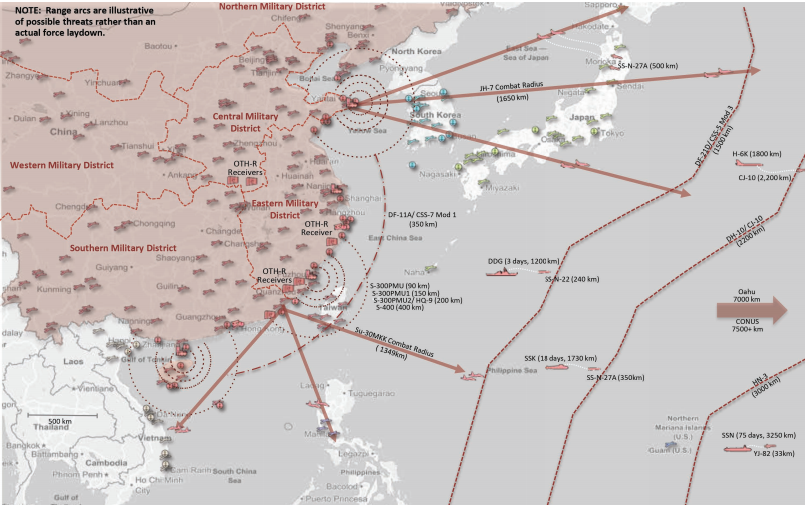The US Missile System Fueling Sino-American Tensions

Table of Contents
The Role of US Missile Defense Systems in the Asia-Pacific
The deployment of US missile defense systems, particularly the Terminal High Altitude Area Defense (THAAD) and Aegis Ashore systems, has become a major source of friction in Sino-American relations.
THAAD and Aegis Ashore Deployments
- THAAD: Primarily deployed in South Korea, THAAD's advanced radar capabilities and ability to intercept ballistic missiles are seen by China as a direct threat to its strategic deterrence. Its location provides coverage over significant portions of China.
- Aegis Ashore: Deployed in Japan, Aegis Ashore systems share similar capabilities to THAAD, further contributing to China's concerns regarding US missile defense capabilities in the region. These systems enhance US regional ballistic missile defense.
- China's Concerns: China views these deployments as a challenge to its nuclear deterrent and a potential destabilizing factor in the region, leading to increased military spending and retaliatory measures. They argue the systems' radar can penetrate deep into Chinese territory.
- Increased Military Spending: China's response has included a significant increase in its military budget, focusing on the development of advanced anti-access/area denial (A2/AD) weapons systems. This further fuels the arms race dynamic.
The Impact on Regional Stability
The deployment of these US missile defense systems has had a significant impact on regional stability.
- Increased Mistrust: It has fueled mistrust and heightened military tensions, increasing the risk of miscalculation and accidental escalation.
- Regional Perspectives: While South Korea and Japan view these deployments as necessary for their security, other countries in the region express concerns about the potential for escalation.
- International Treaties: The deployments have also raised questions about compliance with various international treaties and agreements related to arms control and non-proliferation.
- Expert Opinion: Many security experts warn that the current trajectory increases the likelihood of conflict in the Asia-Pacific region.
China's Military Modernization and Countermeasures
China's response to the perceived threat posed by US missile defense systems has involved significant military modernization and the development of advanced countermeasures.
DF-21D and other Anti-Access/Area Denial (A2/AD) Weapons
- DF-21D: China's development of the DF-21D anti-ship ballistic missile, among others, is designed to neutralize US naval power projection capabilities in the region. This capability directly challenges US military dominance.
- A2/AD Capabilities: China's broader A2/AD strategy aims to create a defensive perimeter around its coastal areas, limiting the ability of adversaries, primarily the US, to operate freely in the region. This impacts freedom of navigation.
- Impact on US Strategy: The development of these systems necessitates a reevaluation of US military strategy in the Asia-Pacific, requiring adaptation and potentially increased military spending.
- Freedom of Navigation: China's A2/AD capabilities raise concerns regarding freedom of navigation in the South China Sea and other strategically important waterways.
The Arms Race Dynamic
The interplay between US missile deployments and China's military modernization creates a dangerous arms race dynamic.
- Cyclical Escalation: This continuous cycle of military buildup and counter-buildup contributes significantly to heightened tensions and the risk of conflict.
- Economic Consequences: This arms race has significant economic consequences for both nations, diverting resources from other pressing domestic needs.
- Unintended Consequences: The potential for unintended consequences, including accidental escalation or miscalculation, is a major concern.
Diplomatic Efforts and De-escalation Strategies
Addressing the escalating tensions requires a concerted effort towards de-escalation through diplomatic means.
The Importance of Communication and Dialogue
- Open Communication: Maintaining open communication channels and fostering dialogue between the US and China are crucial for managing the crisis. This includes military-to-military communication to reduce the chances of accidents.
- Past Initiatives: While past diplomatic initiatives have yielded some results, more sustained and comprehensive efforts are needed. These efforts should aim to understand each others' security concerns.
- International Organizations: The role of international organizations in mediating and facilitating dialogue and de-escalation efforts cannot be underestimated.
Arms Control and Confidence-Building Measures
- Arms Control Agreements: Exploring potential arms control agreements or confidence-building measures could help reduce tensions and foster greater stability. This might involve transparency in military exercises.
- Challenges in Achieving Agreements: However, achieving such agreements will be challenging, given the deep mistrust and conflicting security interests. Reaching consensus on verification mechanisms is crucial.
- Potential Solutions: Strategies could involve establishing clear communication protocols and creating mechanisms for de-escalation in times of crisis.
Conclusion
The US missile system plays a significant role in fueling Sino-American tensions. The deployment of THAAD and Aegis Ashore, coupled with China's development of A2/AD capabilities, has created a dangerous cycle of military buildup and counter-buildup. Understanding the complexities of the US missile system and its impact on Sino-American relations is crucial for fostering global stability. The need for open communication, diplomatic efforts, and potential arms control agreements cannot be overstated. Continue exploring this critical issue by researching further into the complexities of the relationship between these two global powers and the potential for de-escalation strategies to mitigate the risk of conflict.

Featured Posts
-
 Man Utd Striker Transfer Talks Agents Arrival Signals Acceleration
May 20, 2025
Man Utd Striker Transfer Talks Agents Arrival Signals Acceleration
May 20, 2025 -
 The David Walliams Simon Cowell Britains Got Talent Row
May 20, 2025
The David Walliams Simon Cowell Britains Got Talent Row
May 20, 2025 -
 Is Big Bear Ai A Smart Investment Now
May 20, 2025
Is Big Bear Ai A Smart Investment Now
May 20, 2025 -
 12 Best Ai Stocks Redditors Recommend
May 20, 2025
12 Best Ai Stocks Redditors Recommend
May 20, 2025 -
 Protomagia 2024 Programma Ekdromis Sto Oropedio Evdomos
May 20, 2025
Protomagia 2024 Programma Ekdromis Sto Oropedio Evdomos
May 20, 2025
